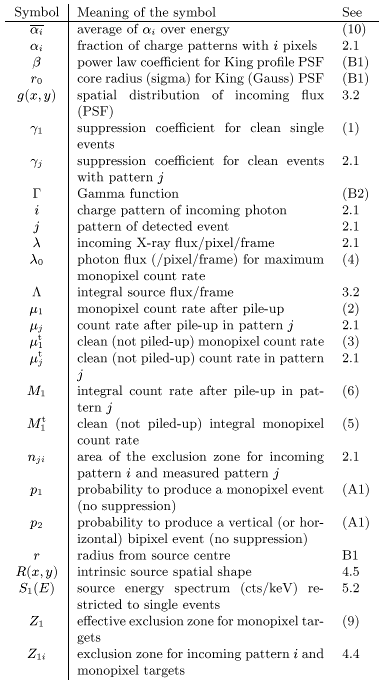
|
After the ASCA/SIS, the next generation of X-ray astronomy satellites will all incorporate CCD detectors (AXAF/ACIS, SPECTRUM-X/JET-X, XMM/EPIC). The reason is that they are very versatile, offering good quantum efficiency, spatial resolution and reasonable energy resolution (Lumb et al. 1991).
The principle of an X-ray CCD detector is that the whole detector is read out at regular intervals. The contents of the detector as it is read out is called a frame. A local excess in the charge contents is called an event, and is usually associated with a single X-ray impact. The total charge content of the event (in excess of the average) is directly proportional to the X-ray energy (with some dispersion of course), and is used as the energy measure.
The underlying hypothesis is that an event is due to only one X-ray. If an event is actually due to several superposed X-rays, then both the count rate and the energy measurements are wrong. This phenomenon (X-ray superposition) is known as pile-up. In order to avoid pile-up, frames are read out as often as possible (typically every few seconds). Nevertheless, when the collecting area of the telescope is large and the point spread function (PSF) is good (desirable features for an X-ray satellite), there will always be sources bright enough that a large number of photons will concentrate in a small area of the CCD. For example, for the XMM/EPIC-MOS (Villa et al. 1996) the flux limit for using the instrument in normal (full CCD) mode with negligible pile-up is about 0.5 10-2 cts/pixel/frame at maximum, or 0.15 mCrab for a point source (Erd et al. 1996). This is a very severe limitation! There are ways to accelerate the CCD read-out, by reading only a selected area of the CCD, but at the price of losing the area of sky corresponding to the rest of the CCD.
The aim of the current paper is to quantify the pile-up problem, and to investigate whether the effect is manageable, in the sense that it may still be possible to use data we know are affected by pile-up. In Sect. 2 and 6 the probability of obtaining various pixel patterns (in XMM parlance) or grades (in ASCA parlance) is quantified for arbitrary input flux. The next sections apply these formulae to the case of point sources for detectors with pixels which are small compared to the PSF, such as XMM/EPIC-MOS or ASCA/SIS. Section 3 and 7 deal with the radial count rate profiles for a point source, and investigate the relationship between the integrated count rate and the input flux. Section 4 shows how to deal with a number of observational complications. Section 5 sums up the paper's results, as a guide to observers. The numerical examples are given using parameters appropriate to the XMM/EPIC-MOS. 8 compares the model with real data. Table 1 sums up all notations used in the paper.

|
Copyright The European Southern Observatory (ESO)